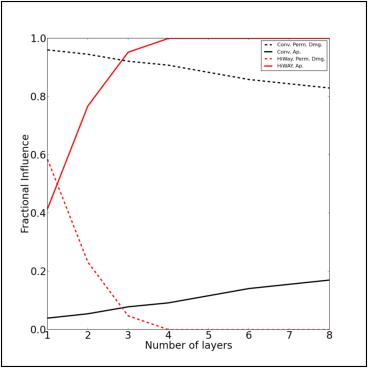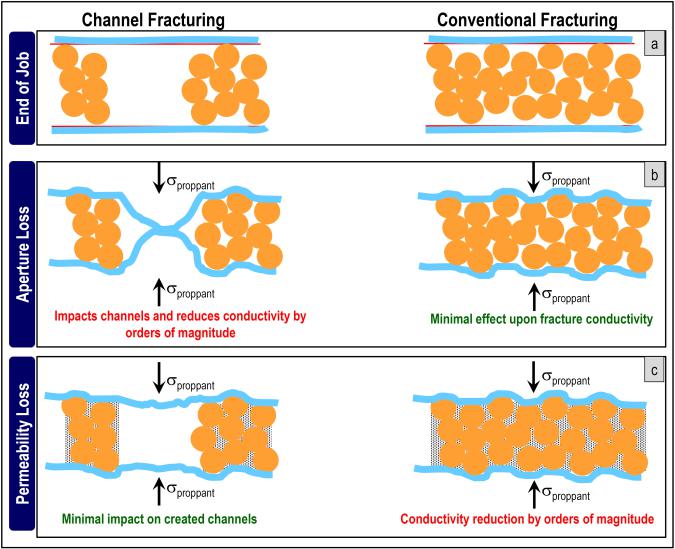
- •Application of Channel Fracturing in the Vaca Muerta Shale Formation
- •Introduction
- •Numerical Model for Predicting Fracture Conductivity under Closure Stress
- •The Relative Effect of Embedment upon Conventional and Channel Fracturing Performance
- •Relative role of aperture and proppant permeability damage
- •Influence of proppant mesh size
- •Discussions
- •Conclusions
- •Acknowledgments
- •References

6 |
SPE-169383-MS |
|
|
Figure 5—Estimates of the fraction of conductivity reduction due to loss of aperture due to embedment and permeability damage within the proppant pack as a function of the number of 30/50 proppant layers. For monolayers, channel fracturing sees some influence of the proppant permeability upon the fracture conductivity. However, for 3 or more layers, the channel fracture conductivity is dominated by the aperture and is essentially independent of the proppant permeability. In contrast, the conventionally propped fracture sees a slow increase in the influence of aperture as the number of layers is increased and the conductivity is dominated by the permeability of the pack.
Relative role of aperture and proppant permeability damage
Our detailed model results allow us to study the mechanisms influencing conductivity reduction for each scenario. In particular, we can calculate separately the reduction in conductivity due to permeability damage in the proppant pack and aperture loss due to embedment at the stress level where channel fracturing and conventional intersect (Fig. 5). These results indicate that regardless of the number of layers, the performance of channel fracturing is most strongly influenced by the embedment of the proppant leading to a reduction in aperture rather than the loss of conductivity within the proppant pack. In contrast, the performance of a uniformly propped fracture is always dominated by the permeability of the pack itself. With increasing numbers of proppant layers we see that the loss of aperture plays a slightly larger role in the conductivity of uniformly propped fractures. In contrast, the shift in mechanism controlling channel fracture conductivity is much more strongly influenced by the number of layers and with only 3 to 4 layers, the channel fracture conductivity becomes essentially independent of the permeability of the proppant pack.
Influence of proppant mesh size
Additional proppant embedment tests were performed to assess the influence of proppant type upon the amount of embedment and the reduction in conductivity (Table 2). The embedment data reported in this study are a percentage of proppant particle diameter. For example, 100% embedment corresponds to full closure of the fracture upon a monolayer but roughly a loss of half the aperture for a double layer of proppant. The embedment data indicate that the smaller 50/120 proppant undergoes significantly less embedment in terms of permanent loss of aperture due to embedment. At the same time, we observe that the smaller 50/120 proppant experiences similar loss in permeability with increasing stress for the same

SPE-169383-MS |
|
|
|
7 |
|
||||
Table 2—Vaca Muerta shale embedment results for 50/120 and 30/50 proppants |
||||
|
|
|
|
|
Proppant Mesh Size |
Proppant Mean Diameter, in |
Proppant Loading |
Test Fluid |
Embedment, % |
|
|
|
|
|
50/120 |
0.002 |
2 |
3%KCl |
43.5 |
50/120 |
0.002 |
4 |
3%KCl |
20.3 |
30/50 |
0.019 |
1 |
3%KCl |
31.4 |
30/50 |
0.019 |
2 |
3%KCl |
44.0 |
|
|
|
|
|
Figure 6—Comparison of fracture conductivity loss between Channel and conventional fracturing techniques. (a) Fracture system at the end of stimulation treatment upon shut down. (b) Impact of aperture loss on fracture profile with applied stress on proppant pack. (c) Degradation impact on proppant pack permeability.
width of 30/50 proppant pack (Fig. 3). We have demonstrated that the loss in conductivity experienced by channel fracturing is independent of proppant conductivity, provided that a proppant pack thickness of approximately 1.5 mm or more is in place. This suggests that channel fracturing can be successful, even with significant embedment, provided that sufficient proppant is placed. Note also that the volume of proppant employed with channel fracturing will typically be half that employed to uniformly prop the fracture to the same aperture. That is, two layers of proppant for the channel fracturing scenario
8 |
SPE-169383-MS |
|
|
approximately correspond to a monolayer of uniformly distributed proppant. This will ultimately reduce the overall completion, logistics, and handling costs.
Discussions
Fig. 6 presents a summary of the key results from this study. With a conventional fracturing technique, hydrocarbon flow is attained primarily through the proppant pack (permeability) and as a result, is greatly affected by degradation of the created proppant pack peameability. Conversely, with the channel fracturing technique, fluid flowis primarily through the established channels around the “pillars”, thus, there is little or no productivity loss due to degradation of the proppant pack permeability. But loss of aperture significantly reduces the hydrocarbon flow potential and ultimately the well performance. The severity of this negative impact varies across the different Vaca Muerta intervals due to their different rock properties.
From a completion perspective, it is critical that any stimulation design be tailored to match the unique properties across each interval. Specifically, higher fracture conductivity is more critical in improving the production performance across the lower intervals, while fracture surface area or extent of the created fracture system plays a more dominant role across the middle and upper intervals (Ejofodomi et al. 2013).
Since one of the key attributes of Channel fracturing is the creation of channels with “infinite” or significantly large fracture conductivities not achieveable via conventional fracturing, it would seem logical that this technique would be best applicable across the lower Vaca Muerta intervals. But the results from this study show otherwise, i.e. loss of aperture due to embedment and the unique reservoir property significantly hinders the fluid flow deliverability and ultimately the well performance. But since fracture conducitivty plays a significant part across the lower interval, the challenge now becomes designing or modifying the Channel fracturing treatment to mitigate some of the potential aperture losses that may occur. Some design considerations might include smaller pillar spacing, larger proppant loading, etc.).
Application of Channel fracturing across the middle and upper Vaca Muerta intervals would ultimately enhance the production performance across these intervals. These intervals tend to be stiffer than the lower section, thus the integrity of the created fracture system is sustained better. Therefore, application of Channel fracturing in these sections would extend the effective region of the created fracture system or essentially increase the fracture surface area, which would improve the production performance.
Conclusions
●A detailed parametric study was performed to investigate the expected relative performance of conventional versus channel fracturing by explicitly addressing the spatial distribution of proppant within the fractures. For computational efficiency we employed a simulator based on the boundary element method.
●In conventional fracturing, loss of aperture has minimal impact on fracture conductivity. Permeability degradation of the proppant pack reduces the fracture conductivity by orders of magnitude
●Conventional effect of permeability degradation can be reduced by increasing the number of proppant layers. This implies the need for high fracture conductivity, which ultimately improves the production performance, although to varying degree across the different Vaca Muerta intervals (Ejofodomi et al 2013)
●In Channel fracturing, permeability degradation of the proppant pack does not affect created channels. Loss of aperture impacts the created channels and reduces the fracture conductivity by orders of magnitude
